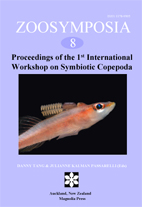Abstract
Infections with the pennellid Peniculus minuticaudae Shiino, 1956 occurred on three species of marine fishes, the unicorn leatherjacket filefish, Aluterus monoceros (L.), the hairfinned leatherjacket, Paramonacanthus japonicus (Tilesius), and the brown-banded butterflyfish, Roa modesta (Temminck & Schlegel), held at a public aquarium in Kagoshima, Japan. Using specimens from the aquarium and type material, the postmetamorphic and premetamorphic adult females of P. minuticaudae are redescribed. The adult male, copepodid I, and late chalimus stages are described for the first time. The three fish species represent new host records for P. minuticaudae. Fishes were found heavily infected with P. minuticaudae, and extensive lesions associated with infections were found on the skin and around the fin rays of R. modesta. While pennellids usually use two hosts during their life cycle, it is very likely that P. minuticaudae completes its life cycle using one host, as suggested by copepodids, chalimi, adult males, premetamorphic adult females, and postmetamorphic adult females of the parasite all being found on a single fish.

